Memoir of John Shakespear Bartley, 1916-1919 - Part 8
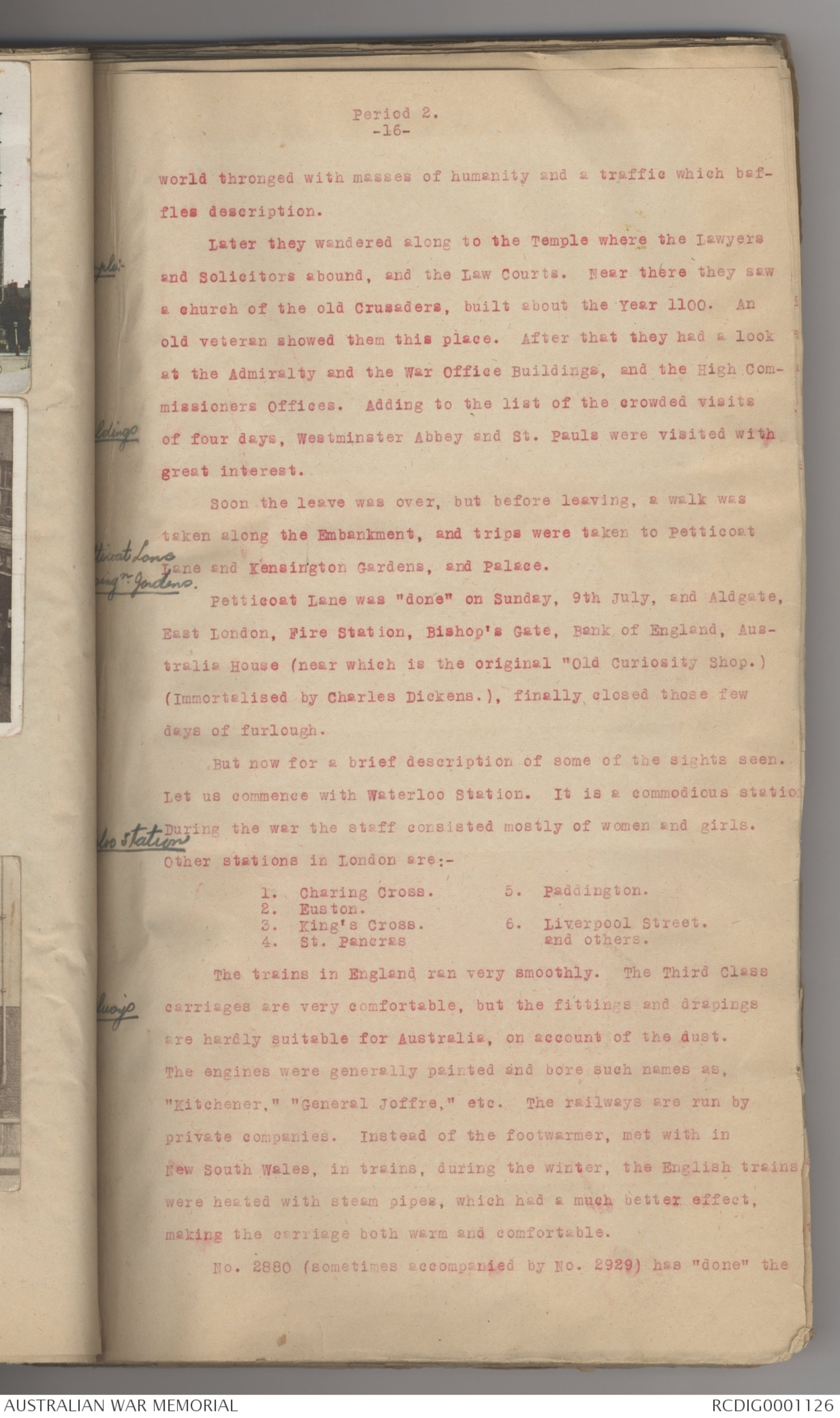
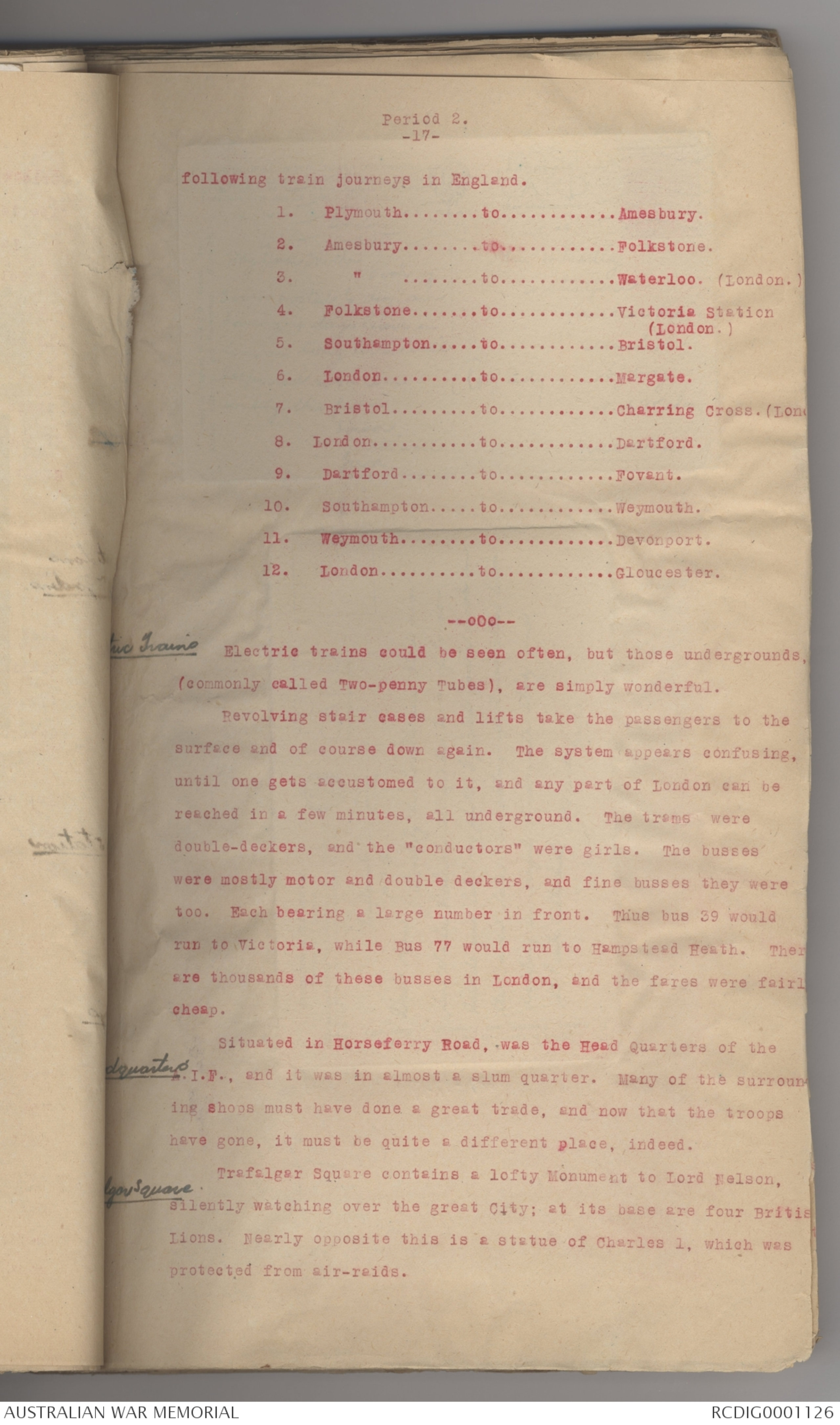
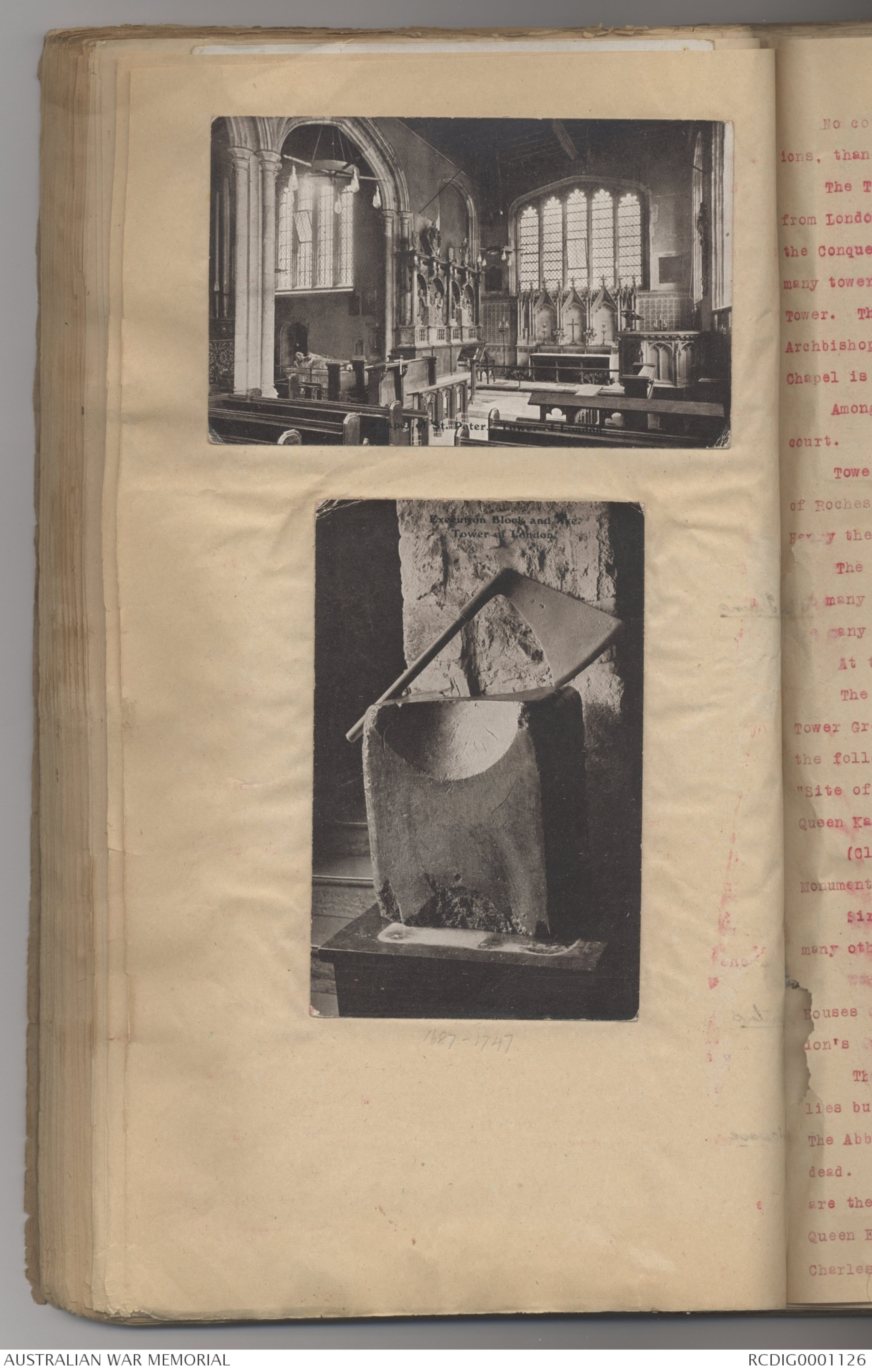
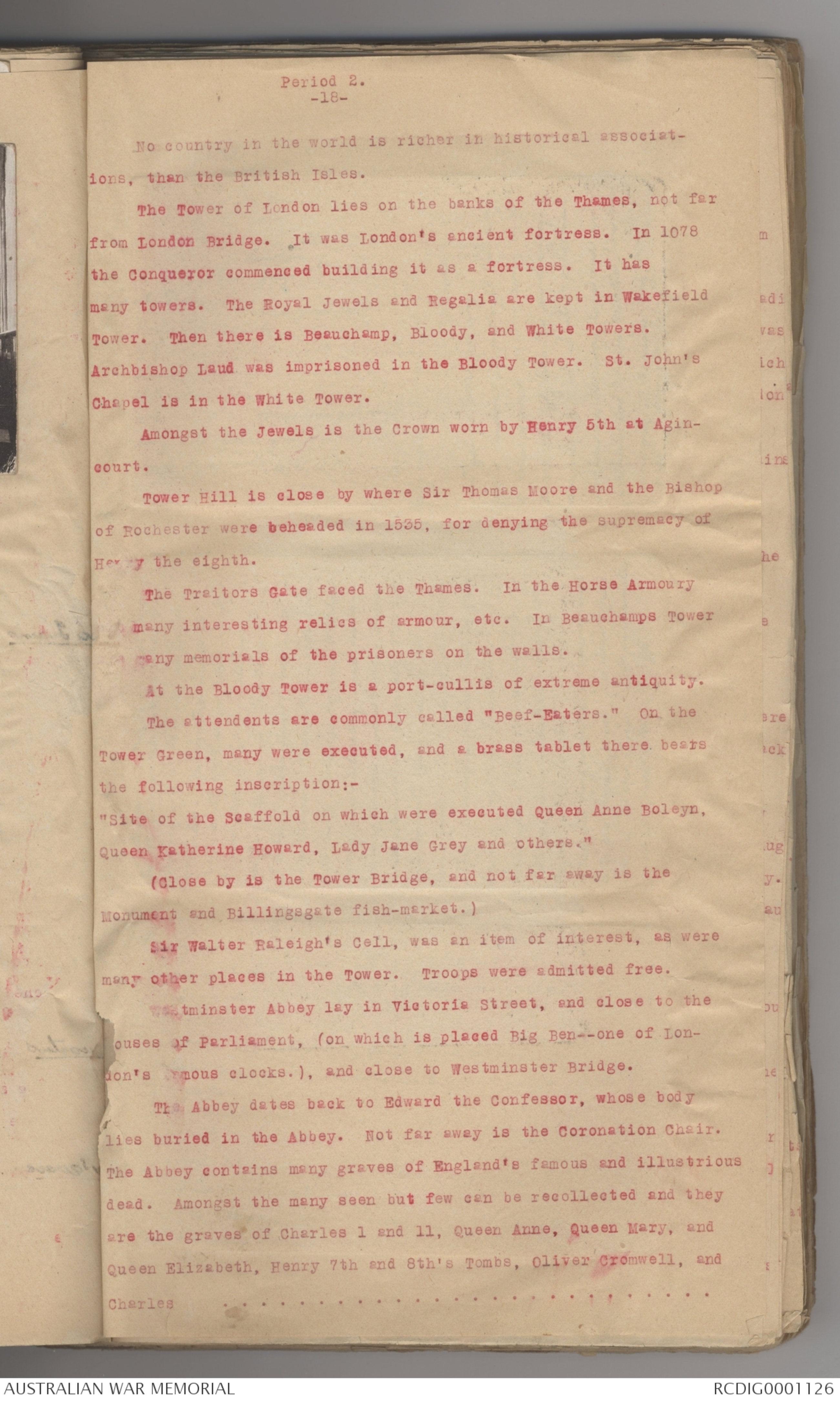
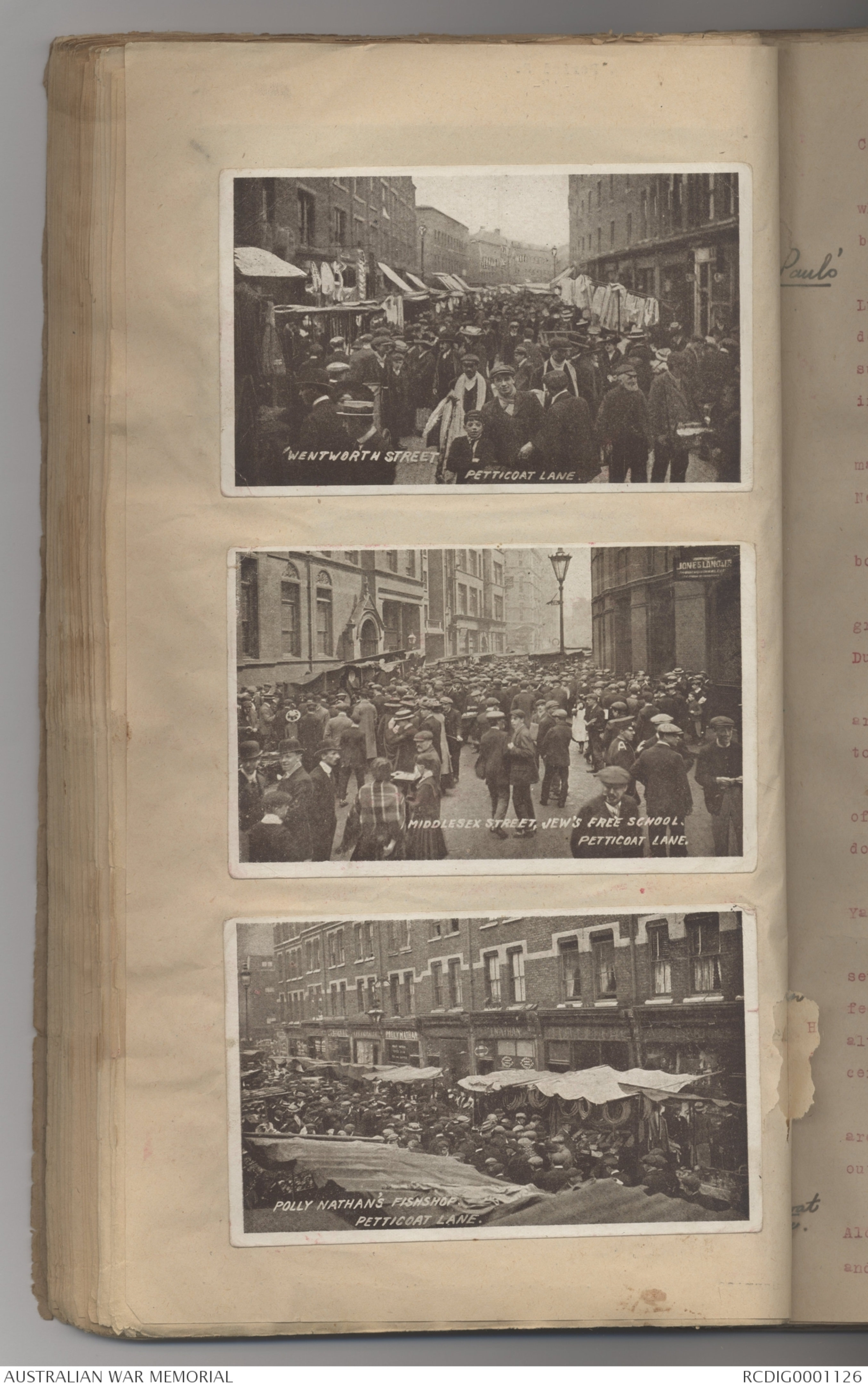
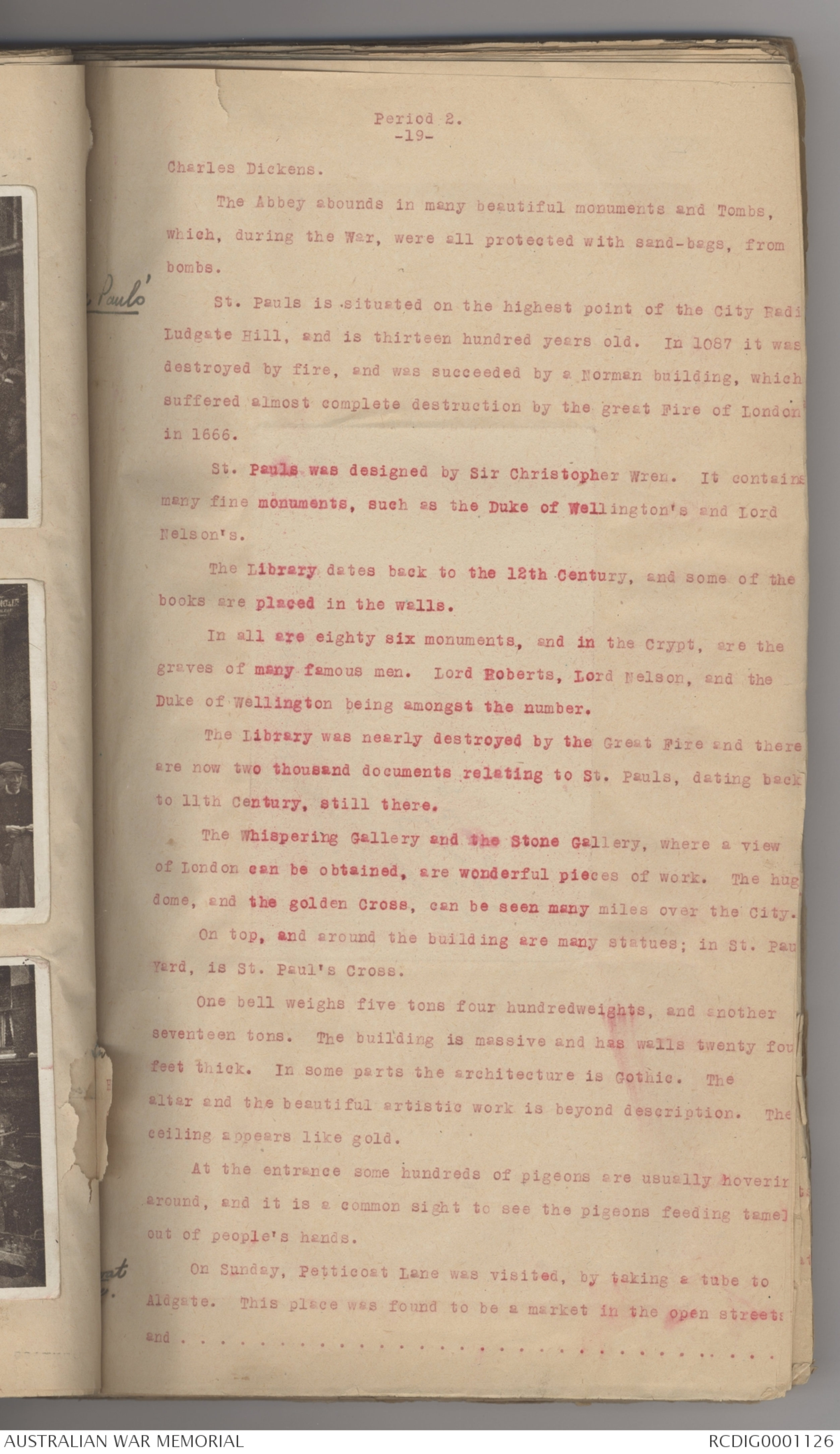
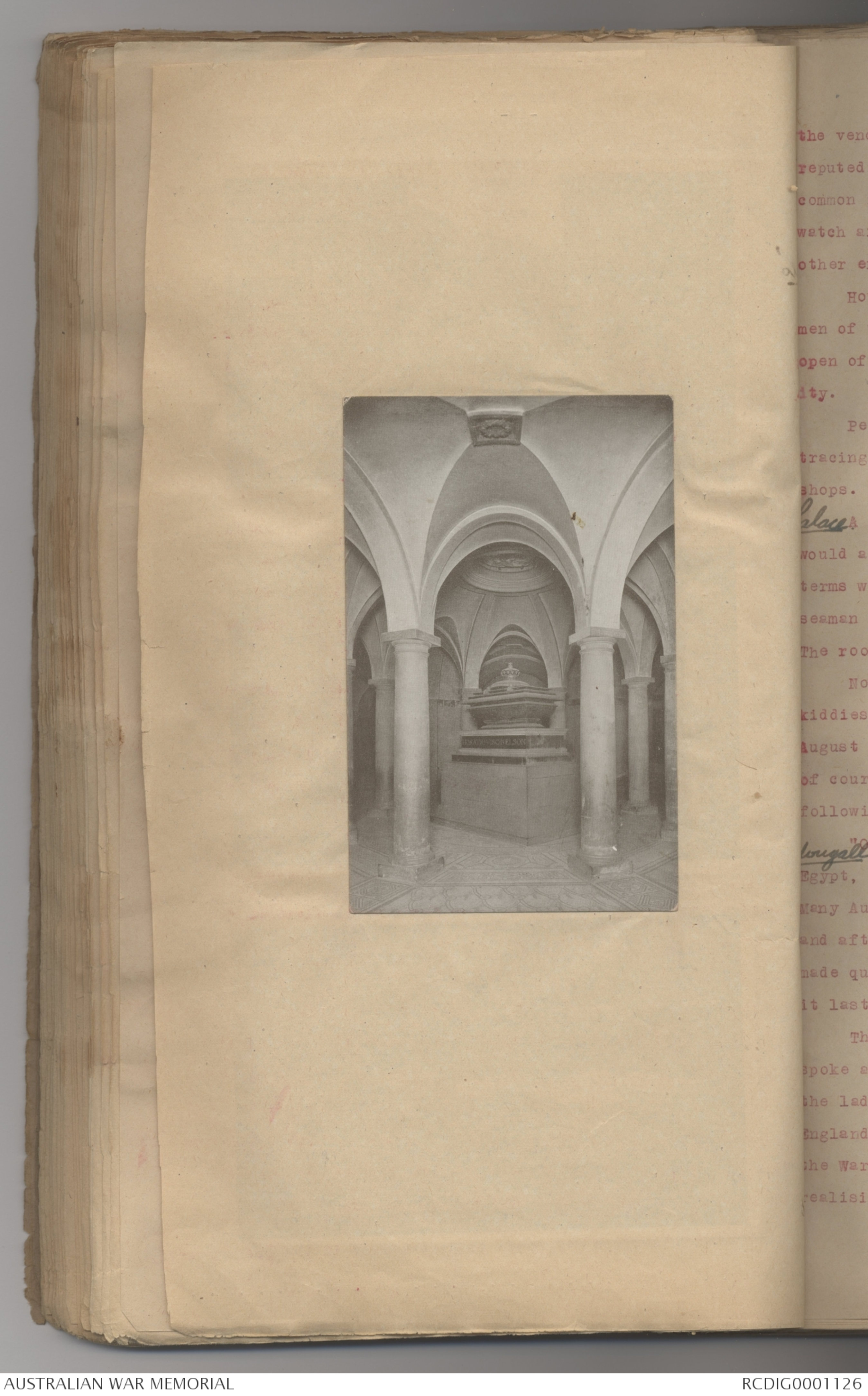
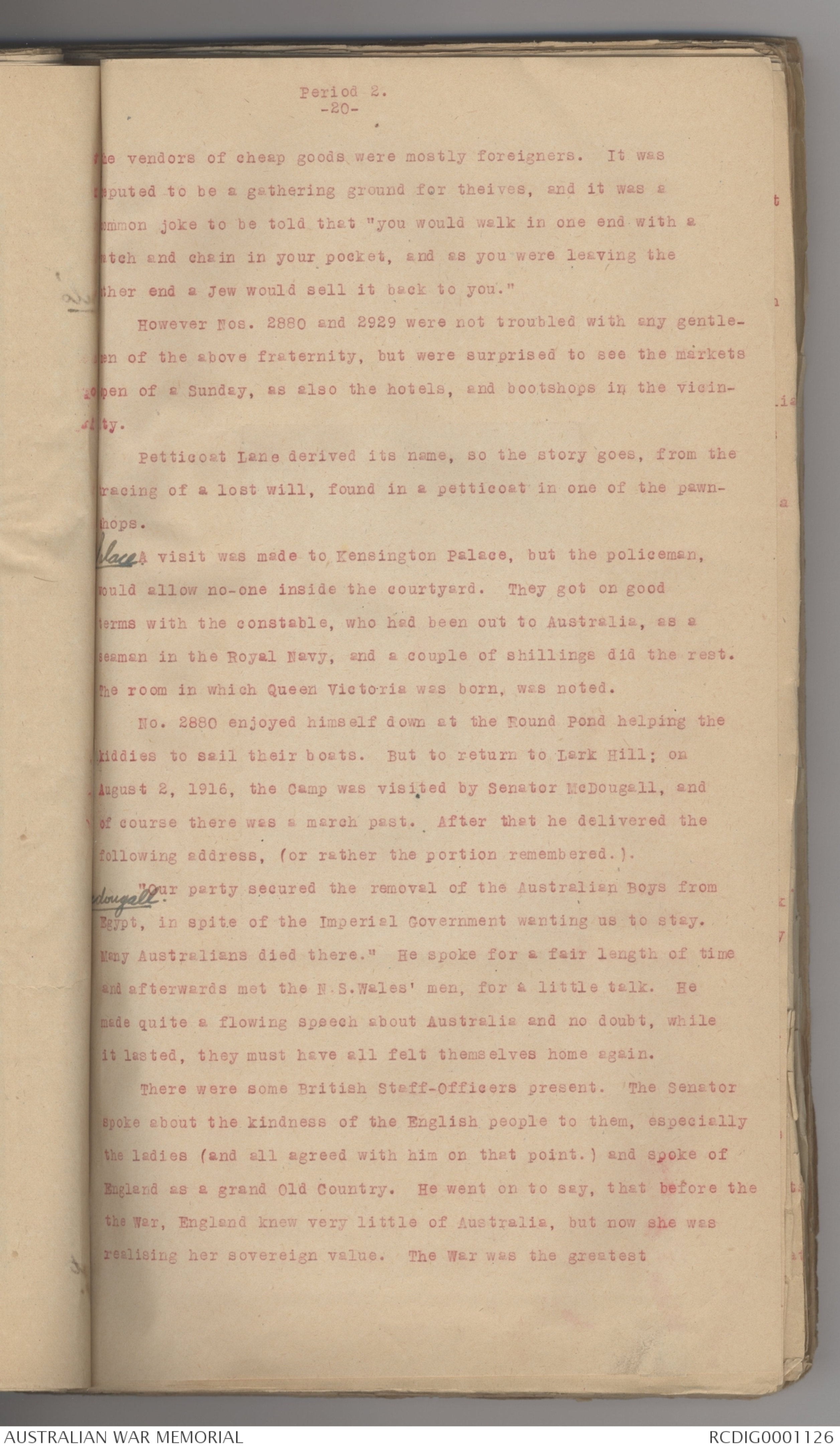
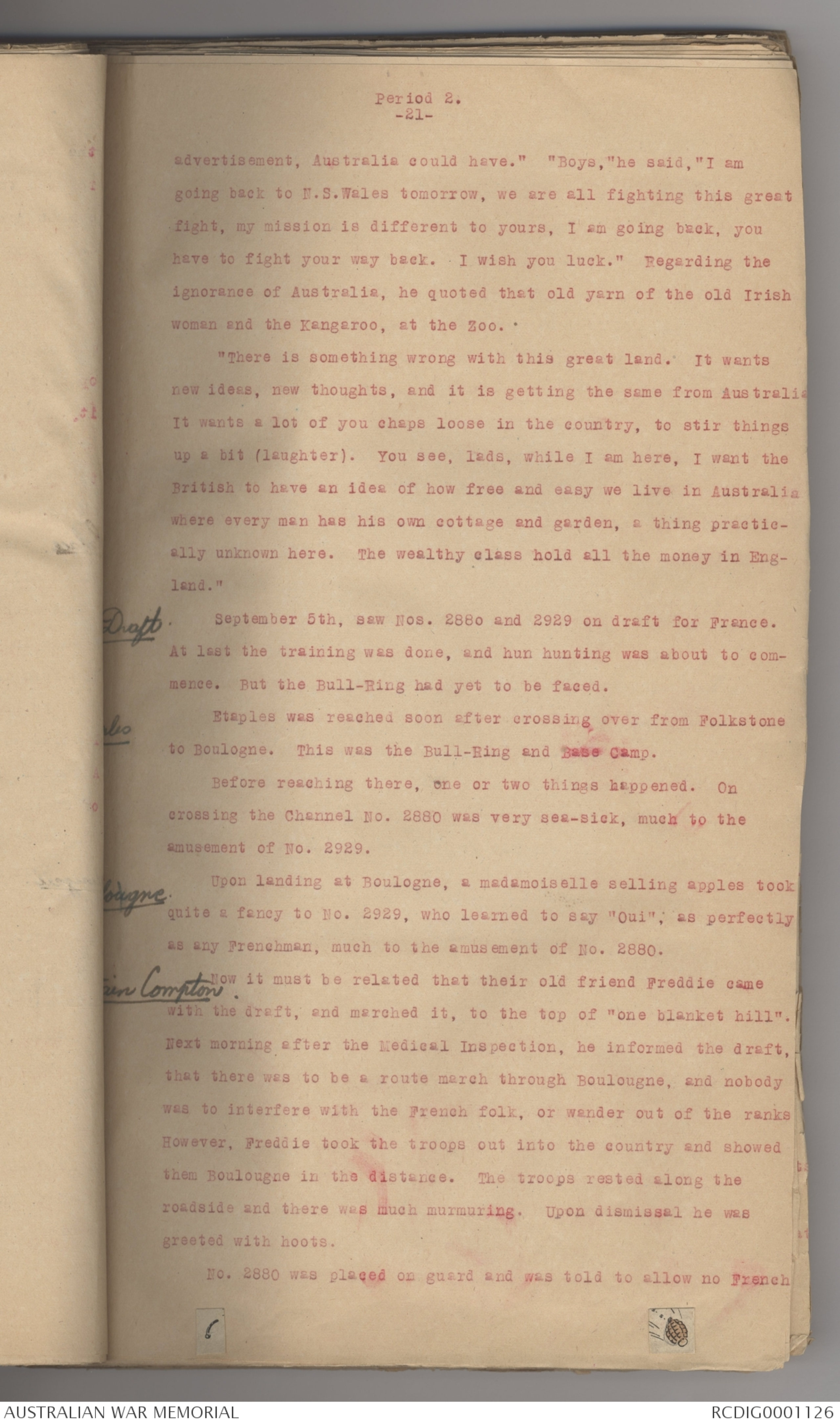
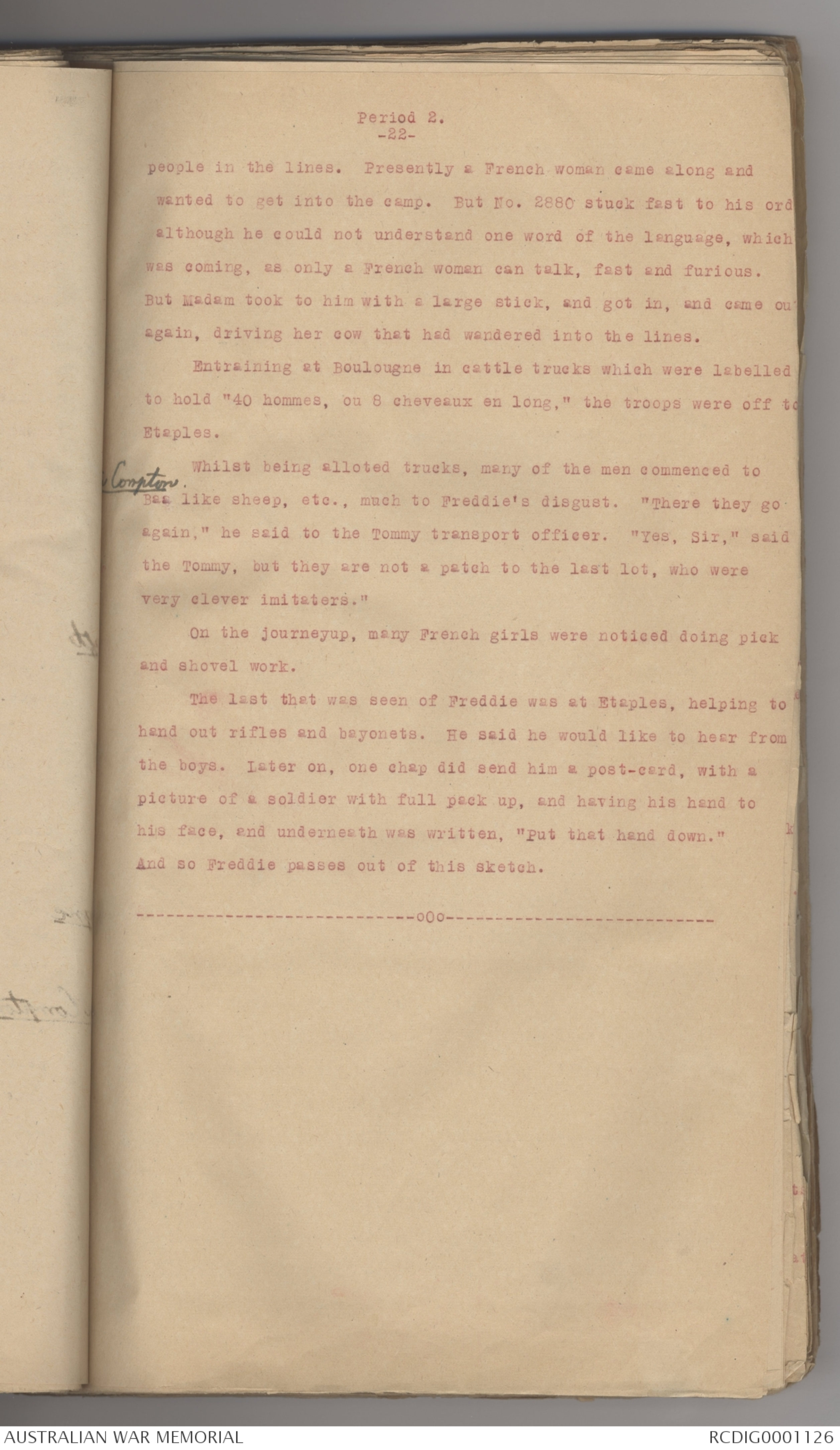
Period 2.
-16-
world thronged with masses of humanity and a traffie which baffles
description.
Later they wandered along to the Temple where the Lawyers
and Solicitors abound, and the Law Courts. Near there they saw
a church of the old Crusaders, built about the Year 1100. An
old veteran showed them this place. After that they had a look
at the Admiralty and the War office Buildings, and the High Commissioners
Offices. Adding to the list of the crowded visits
of four days, Westminster Abbey and St. Pauls were visited with
great interest.
Soon the leave was over, but before leaving, a walk was
taken along the Embankment, and trips were taken to Petticoat
Lane and and Kensington Gardens, and Palace.
Petticoat Lane was "done" on Sunday, 9th July, and Aldgate,
East London, Fire Station, Bishop's Gate, Bank of England, Australia
House (near which is the original "Old Curiosity Shop.)
(Immortalised by Charles Dickens.), finally closed those few
days of furlough.
But now for a brief description of some of the sights seen.
Let us commence with Waterloo Station. It is a commodious station
During the war the staff consisted mostly of women and girls.
Other stations in London are:-
1. Charing Cross. 5. Paddington
2. Euston. 6. Liverpool Street
3. King's Cross. and others.
4. St. Pancras
The trains in England ran very smoothly. The Third Class
carriages are very comfortable, but the fittings and drapings
are hardly suitable for Australia, on account of the dust.
The engines were generally painted and bore such names as,
"Kitchener," "General Joffre," etc. The railways are run by
private companies. Instead of the footwarmer, met with in
New South Wales, in trains, during the winter, the English trains
were heated with steam pipes, which had a much better effect,
making the carriage both warm and comfortable.
No. 2880 (sometimes accompanied by No. 2929) has "done" the
Period 2.
-17-
following train journeys in England.
1. Plymouth.............to............Amesbury.
2. Amesbury.............to............Folkstone.
3. " ..........to............ Waterloo. (London)
4. Folkstone.............to............Victoria Station ( London)
5. Southampton...to............ Bristol.
6 London................. to............Margate.
7. Bristol.........to............Charring Cross. (London)
8. London...........to............ Dartford.
9. Dartford........to............Fovant.
10. Southampton.....t0............Weymouth.
11. Weymouth.........to............Devonport.
12. London..........to............Gloucester.
[*Two Trains*]
Electric trains could be seen often, but those undergrounds
(commonly called Two-penny Tubes), are simply wonderful.
Revolving stair cases and lifts take the passengers to the
surface and of course down again. The system appears confusing,
until one gets accustomed to it, and any part of London can be
reached in a few minutes, all underground. The trams were
double-deckers, and the "conductors" were girls. The busses
were mostly motor and double deckers, and fine busses they were
too. Each bearing a large number in front. Thus bus 39 would
run to Victoria, while Bus 77 would run to Hampstead Heath. There
are thousands of these busses in London, and the fares were fairly
cheap.
Situated in Horseferry Road, was the Head Quarters of the
A.I.F., and it was in almost a slum quarter. Many of the surrounding
shops must have done a great trade, and now that the troops
have gone, it must be quite a different place, indeed.
Trafalgar Square contains a lofty Monument to Lord Nelson,
silently watching over the great City; at its base are four British
Lions. Nearly opposite this is a statue of Charles 1, which was
protected from air-raids.
Two Photos - See original document
Period 2.
-18-
No country in the world is richer in historical associations,
than the British Isles.
The Tower of London lies on the banks of the Thames, not far
from London Bridge. It was London's ancient fortress. In 1078
the Conqueror commenced building it as a fortress. It has
many towers. The Royal Jewels and Regalia are kept in Wakefield
Tower. Then there is Beauchamp, Bloody, and White Towers.
Archbishop Laud was imprisoned in the Bloody Tower. St. John's
Chapel is in the White Tower.
Amongst the Jewels is the Crown worn by Henry 5th at Agincourt.
Tower Hill is close by where Sir Thomas Moore and the Bishop
of Rochester were beheaded in 1535, for denying the supremacy of
Henry the eighth.
The Traitors gate faced the Thames. In the Horse Armoury
many interesting relies of armour, etc. In Beauchamps Tower
many memorials of the prisoners on the walls.
At the Bloody Tower is a port-cullis of extreme antiquity.
The attendents are commonly called "Beef-Eaters." On the
Tower Green, many were executed, and a brass tablet there bears
the following inscription:-
"Site of the Scaffold on which were executed Queen Anne Boleyn,
Queen Katherine Howard, Lady Jane Grey and others."
(Close by is the Tower Bridge, and not far away is the
Monument and Billingsgate fish-market.)
Sir Walter Raleigh's Cell, was an item of interest, as were
many other places in the Tower. Troops were admitted free.
Westminster Abbey lay in Victoria Street, and close to the
Houses of Parliament, (on which is placed Big Ben--one of London's
famous clocks.), and close to Westminster Bridge.
The Abbey dates back to Edward the Confessor, whose body
lies buried in the Abbey. Not far away is the Coronation Chair.
The Abbey contains many graves of England's famous and illustrious
dead. Amongst the many seen but few can be recollected and they
are the graves of Charles 1 and 11, Queen Anne, Queen Mary, and
Queen Elizabeth, Henry 7th and 8th's Tombs, Oliver Cromwell, and
Charles
Three photos - See original document
Period 2.
-19-
Charles Dickens.
The Abbey abounds in many beautiful monuments and Tombs,
which, during the War, were all protected with sand-bags, from
bombs.
St. Pauls is situated on the highest point of the City Radi
Ludgate Hill, and is thirteen hundred years old. In 1087 it was
destroyed by fire, and was succeeded by a Norman building, which
suffered almost complete destruction by the great Fire of London
in 1666.
St. Pauls was designed by Sir Christopher Wren. It contains
many fine monuments, such as the Duke of Wellington's and Lord
Nelson's.
The Library dates back to the 12th Century, and some of the
books are placed in the walls.
In all are eighty six monuments, and in the Crypt, are the
graves of many famous men. Lord Roberts, Lord Nelson, and the
Duke of Wellington being amongst the number.
The Library was nearly destroyed by the Great Fire and there
are now two thousand documents relating to St. Pauls, dating back
to 11th Century, still there.
The Whispering Gallery and the Stone Gallery, where a view
of London can be obtained, are wonderful pieces of work. The huge
dome, and the golden Cross, can be seen many miles over the City.
On top, and around the building are many statues; in St. Paul's
Yard, is St. Paul's Cross.
One bell weighs five tons four hundredweights, and another
seventeen tons. The building is massive and has walls twenty four
feet thick. In some parts the architecture is Gothic. The
alter and the beautiful artistic work is beyond description. The
ceiling appears like gold.
At the entrance some hundreds of pigeons are usually hovering
around, and it is a common sight to see the pigeons feeding tamel
out of people's hands.
On Sunday, Petticoat Lane was visited, by taking a tube to
Aldgate. This place was found to be a market in the open street
and...
Photo - See original document
Period 2.
-20-
The vendors of cheap goods were mostly foreigners. It was
reputed to be a gathering ground for theives, and it was a
common joke to be told that "you would walk in one end with a
watch and chain in your pocket, and as you were leaving the
other end a Jew would sell it back to you."
However Nos. 2880 and 2929 were not troubled with any gentlemen
of the above fraternity, but were surprised to see the markets
open of a Sunday, as also the hotels, and bootshops in the vicinity.
Petticoat Lane derived its name, so the story goes, from the
tracing of a lost will, found in a petticoat in one of the pawnshops.
A visit was made to Kensington Palace, but the policeman,
would allow no-one inside the courtyard. They got on good
terms with the constable, who had been out to Australia, as a
seaman in the Royal Navy, and a couple of shillings did the rest.
The room in which Queen Victoria was born, was noted.
No. 2880 enjoyed himself down at the Round Pond helping the
kiddies to sail their boats. But to return to Lark Hill; on
August 2, 1916, the Camp was visited by Senator McDougall, and
of course there was a march past. After that he delivered the
following address, (or rather the portion remembered.).
McDougall
"Our party secured the removal of the Australian Boys from
Egypt, in spite of the Imperial Government wanting us to stay.
Many Australians died there." He spoke for a fair length of time
and afterwards met the N.S.Wales' men, for a little talk. He
made quite a flowing speech about Australia and no doubt, while
it lasted, they must have all felt themselves home again.
There were some British Staff-Officers present. The Senator
spoke about the kindness of the English people to them, especially
the ladies (and all agreed with him on that point.) and spoke of
England as a grand Old Country. He went on to say, that before the
the war, England knew very little of Australia, but now she was
realising her sovereign value. The War was the greatest
Period 2.
-21-
advertisement, Australia could have." "Boys, he said,"I am
going back to N.S.Wales tomorrow, we are all fighting this great
fight, my mission is different to yours, I am going back, you
have to fight your way back. I wish you luck." Regarding the
ignorance of Australia, he quoted that old yarn of the old Irish
woman and the Kangaroo, at the zoo.
"There is something wrong with this great land. It wants
new ideas, new thoughts, and it is getting the same from Australia
It wants a lot of you chaps loose in the country, to stir things
up a bit (laughter). You see, lads, while I am here, I want the
British to have an idea of how free and easy we live in Australia
Where every man has his own cottage and garden, a thing practically
unknown here. The wealthy class hold all the money in England."
September 5th, saw Nos. 2880 and 2929 on draft for France.
At last the training was done, and hun hunting was about to commence.
But the Bull-Ring had yet to be faced.
Etaples was reached soon after crossing over from Folkstone
to Boulogne. This was the Bull-Ring and Base Camp.
Before reaching there, one or two things happened. On
crossing the Channel No. 2880 was very sea-sick, much to the
amusement of No. 2929.
Upon landing at Boulogne, a madamoiselle selling apples took
quite a fancy to No. 2929, who learned to say "Oui"; as perfectly
as any Frenchman, much to the amusement of No. 2880.
Now it must be related that their old friend Freddie came
with the draft, and marched it, to the top of "one blanket hill".
Next. morning after the Medical Inspection, he informed the draft,
that there was to be a route march through Boulougne, and nobody
was to interfere with the French folk, or wander out of the ranks
However, Freddie took the troops out into the eountry and showed
them Boulougne in the distarce. The troops rested along the
roadside and there wes much murmuring. Upon dismissal he was
greeted with hoots.
No. 2880 was placed on guard and was told to allow no French
Period 2.
-22-
people in the lines. Presently a French woman came along and
wanted to get into the camp. But No. 2880 stuck fast to his ord
although he could not understand one word of the language, which
was coming, as only a French woman can talk, fast and furious.
But Madam took to him with a large stick, and got in, and came out
again, driving her cow that had wandered into the lines.
Entraining at Boulougne in cattle trucks which were labelled
to hold "40 hommes, ou 8 cheveaux en long," the troops were off to
Etaples.
Whilst being alloted trucks, many of the men commenced to
Baa like sheep, etc., much to Freddie's disgust. "There they go
again," he said to the Tommy transport officer. "Yes, Sir," said
the Tommy, but they are not a patch to the last lot, who were
very clever imitaters."
On the journeyup, many French girls were noticed doing pick
and shovel work.
The last that was seen of Freddie was at Etaples, helping to
hand out rifles and bayonets. He said he would like to hear from
the boys. Later on, one chap did send him a post-card, with a
picture of a soldier with full pack up, and having his hand to
his face, and underneath was written, "Put that hand down."
And so Freddie passes out of this sketch.
 Kate Benn
Kate BennThis transcription item is now locked to you for editing. To release the lock either Save your changes or Cancel.
This lock will be automatically released after 60 minutes of inactivity.